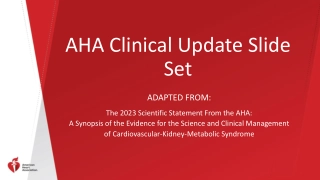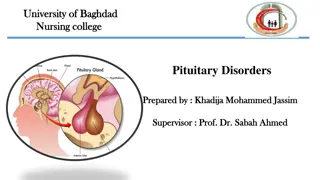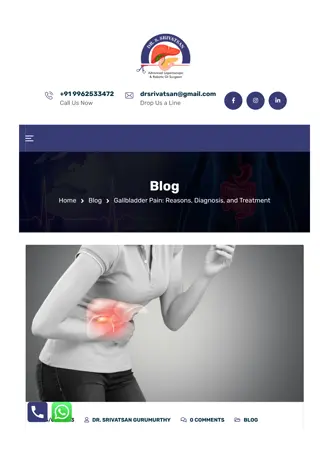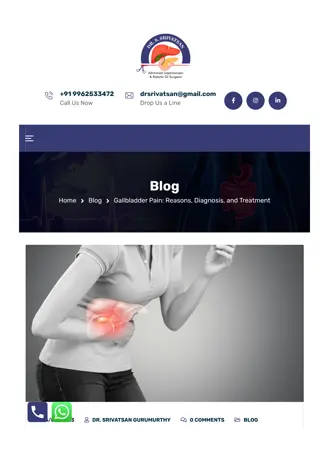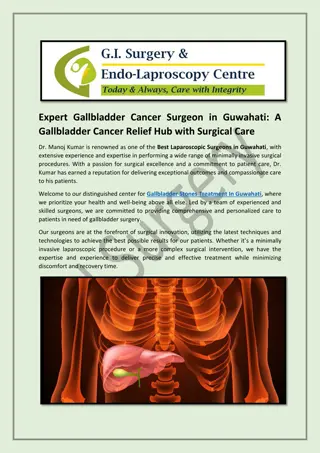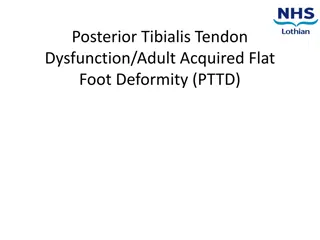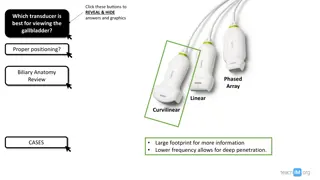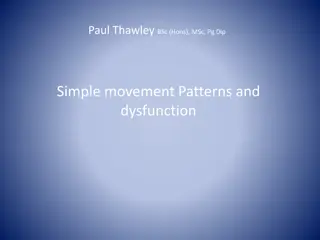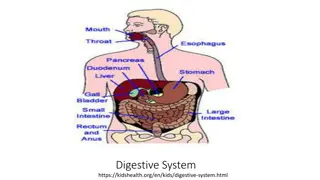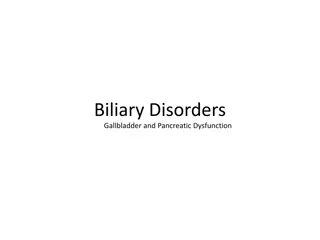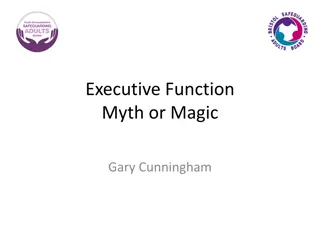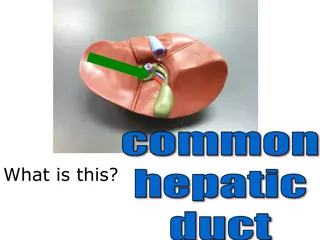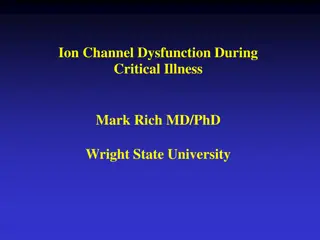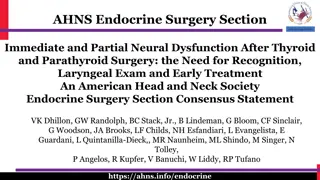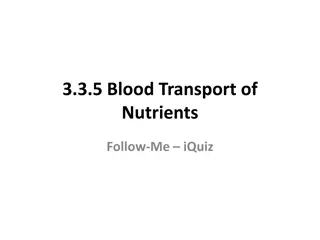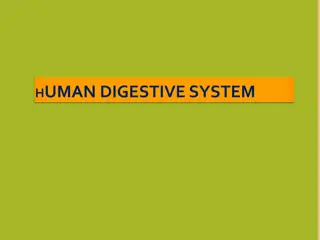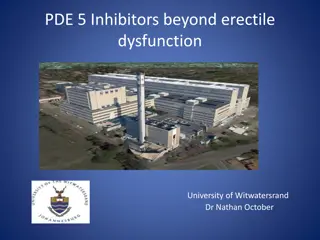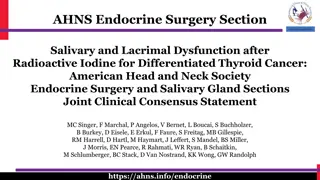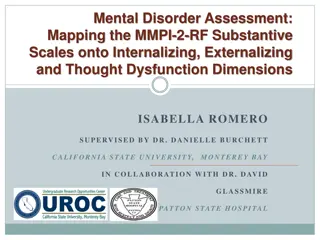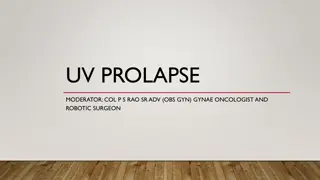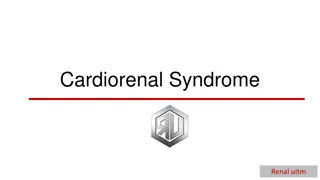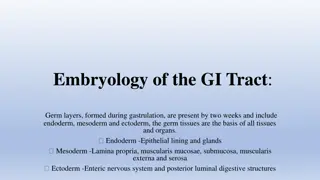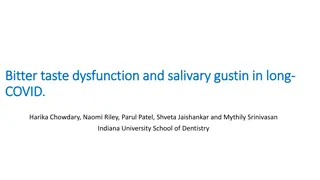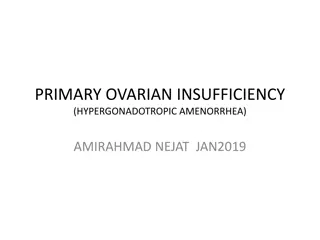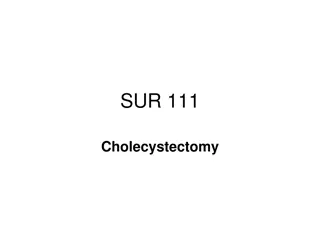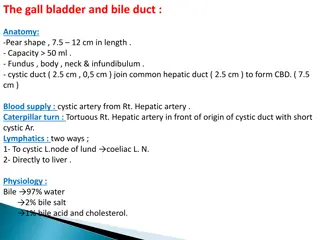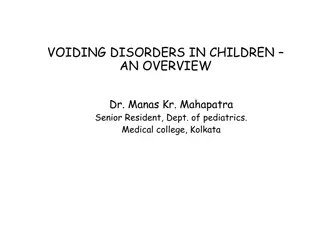AHA Clinical Update Slide Set
The evidence-based science and clinical management of Cardiovascular-Kidney-Metabolic Syndrome (CKM) in this comprehensive slide set. Learn about the pathophysiological interactions, multi-organ dysfunction, and adverse cardiovascular outcomes associated with CKM.
0 views • 14 slides
Cardiovascular Disease in HIV
The increased risk of cardiovascular disease in people with HIV and specific strategies to treat it. This presentation discusses potential mechanisms, comorbidity gaps, and the impact of traditional risk factors. Explore the role of inflammation and immune dysfunction in atherosclerosis and vulnerab
0 views • 38 slides
Understanding Steatotic Liver Disease: Importance, Epidemiology, and Pathology
Steatotic liver disease, including metabolic dysfunction associated steatohepatitis (MASLD) and metabolic associated alcoholic liver disease (MALD), is a common cause of liver test abnormalities in the United States. Risk factors such as obesity and metabolic syndrome can lead to advanced fibrosis a
2 views • 44 slides
Understanding Shock: Causes, Symptoms, and Stages
Shock is a critical condition caused by an imbalance between cellular oxygen supply and demand, leading to organ dysfunction. Compensatory responses include increased heart rate, vasoconstriction, and hormonal adjustments. Recognizable features of shock include tachycardia, hypotension, cool clammy
3 views • 27 slides
Understanding Cholecystitis and Cholelithiasis: Causes, Risk Factors, and Management
Inflammation of the gallbladder (cholecystitis) and the presence of stones in the gallbladder (cholelithiasis) are common conditions. Acute cholecystitis is often caused by gallstones, while chronic cholecystitis can result from repeated attacks or chronic irritation. Risk factors include gender, ag
2 views • 21 slides
Pituitary Disorders
Pituitary disorders, often caused by tumors, can disrupt hormone production leading to various symptoms like weight gain, vision problems, and hormonal imbalances. The pituitary gland plays a crucial role in regulating bodily functions through hormone secretion. Factors such as tumor growth, head in
0 views • 25 slides
Radiological Investigation of Hepatobiliary System and Imaging Modalities Overview
Exploring the hepatobiliary system through radiology, this lecture covers the anatomy, modalities like X-ray, Ultrasound, CT scan, MRI, and nuclear scan used for imaging, their advantages, disadvantages, and indications. It delves into the significance of liver, gallbladder, and biliary duct imaging
2 views • 37 slides
Physiologie Digestive PHASE BUCCALE
Digestive physiology involves the breakdown of food into simple nutrients for absorption by the body. It includes mechanical and chemical means of food degradation using enzymes from salivary, gastric, pancreatic, and colonic bacteria. The digestive system comprises the mouth, esophagus, stomach, li
4 views • 25 slides
Gallbladder Pain Reasons, Diagnosis, and Treatment
Gallbladder pain can be a distressing experience for individuals. Understanding the causes, seeking accurate diagnosis, and receiving proper treatment are essential for managing this condition effectively. In this blog post, we will explore the reasons behind gallbladder pain, the diagnostic process
1 views • 7 slides
Gallbladder Pain Reasons, Diagnosis, and Treatment
we will highlight the expertise and proficiency of Dr. S. Srivatsan Gurumurthy, a renowned Robotic Surgeon in Chennai, who specializes in gallbladder surgeries.
1 views • 7 slides
Best Gallbladder Cancer Surgeon in Guwahati | Gallbladder Stones Treatment
Looking for the best gallbladder cancer surgeon in Guwahati? Dr. Manoj Kumar is renowned for his expertise and successful outcomes in gallbladder cancer treatments. With advanced surgical techniques and compassionate care, Dr. kumar provides top-notch medical services. Trust your health with Guwahat
3 views • 2 slides
Understanding Posterior Tibialis Tendon Dysfunction (PTTD) in Adults
Posterior Tibialis Tendon Dysfunction, also known as Adult Acquired Flat Foot Deformity (PTTD), is a condition that affects the tibialis posterior tendon, leading to reduced arch support. Common causes include obesity, trauma, age, and existing health conditions. Symptoms may include ankle pain, swe
0 views • 12 slides
Understanding Sexual Dysfunction and Associated Factors
Sexual dysfunction encompasses a range of issues that can affect individuals, with causes including psychological, neurological, hormonal, and relationship-related factors. Evaluating sexual problems involves considering duration, context, and frequency. Psychological causes, such as anxiety and str
0 views • 25 slides
Understanding Sacroiliac Joint Dysfunction: A Comprehensive Guide
Discover the intricate anatomy of the spine, learn about the prevalence and causes of lower back pain, delve into the symptoms and diagnosis of sacroiliac joint dysfunction, and explore treatment options to manage this condition effectively.
0 views • 27 slides
Best Transducer and Positioning for Gallbladder Imaging
A 40-year-old man with right-sided epigastric pain is being evaluated for gallbladder issues. The best transducer for viewing the gallbladder is identified, along with proper positioning techniques for optimal imaging. The case includes details on cholelithiasis and management recommendations follow
0 views • 6 slides
Understanding Movement Dysfunction in Sports Medicine
Movement dysfunction in sports medicine can stem from various factors such as structural instability, loss of range of motion, functional rigidity, poor balance, and more. Clinical movement analysis plays a vital role in identifying muscle imbalances and guiding exercise interventions to enhance ath
0 views • 21 slides
Exploring the Intricacies of the Digestive System
The digestive system plays a crucial role in converting food into nutrients and eliminating waste from the body. It involves a complex network of organs such as the mouth, stomach, intestines, liver, pancreas, and gallbladder. Discover interesting facts and details about the digestive system, includ
0 views • 18 slides
Understanding Biliary Disorders and Gallbladder Dysfunction
This informative content delves into the anatomy and function of the gallbladder, discussing its role in storing and concentrating bile. It explains the composition of bile, the process of emulsifying fats, and the consequences of bile flow obstruction. Various disorders affecting the biliary system
0 views • 31 slides
Understanding Executive Functioning and Executive Dysfunction
Executive Functioning is a key aspect of cognitive function, encompassing various abilities such as planning, self-awareness, and emotion regulation. Executive Dysfunction, often resulting from frontal lobe injuries, can lead to difficulties in decision-making, social interactions, and learning. Thi
1 views • 21 slides
Identify Various Organs and Regions in Medical Images
The provided content consists of images showing different organs and regions in the human body, such as the liver, pancreas, gallbladder, esophagus, appendix, and more. These images aim to help individuals understand and recognize these structures for educational or medical purposes.
0 views • 53 slides
Understanding Ion Channel Dysfunction in Critical Illness
An intriguing case study presents a young male with weakness and coma in the ICU following pneumonia and sepsis. Nerve conduction results indicated critical illness myopathy and polyneuropathy, along with cardiac abnormalities. Reduced muscle excitability was attributed to a sodium channelopathy. Th
0 views • 14 slides
Understanding Vocal Fold Paralysis and Neural Dysfunction After Thyroid and Parathyroid Surgery
This consensus statement by the American Head and Neck Society Endocrine Surgery Section highlights the importance of recognizing immediate vocal fold paralysis (VFP) and partial neural dysfunction (PND) following thyroid and parathyroid surgery. The report emphasizes the need for early identificati
0 views • 17 slides
Addressing Cognitive Dysfunction in Patients with Cancer: Causes, Impact, and Treatment
Understanding cognitive dysfunction in cancer patients is crucial for improving quality of life and medical outcomes. This article explores the background, causes, screening, diagnosis, and treatment options for cancer-related cognitive impairment, emphasizing the historical perspective, prevalence,
0 views • 60 slides
Understanding Nutrient Absorption in the Digestive System
This content provides a quiz format to test knowledge on the transport of nutrients in blood, digestive processes, and functions of organs such as the liver and gallbladder. Topics covered include nutrient absorption in the small intestine, enzyme production, emulsification of fats, and more. It als
0 views • 50 slides
Exploring the Human Digestive System: Major Organs and Functions
The human digestive system is a complex network of organs working together to break down food into smaller molecules for absorption. It consists of major organs like the mouth, esophagus, stomach, small intestine, and large intestine, along with accessory organs such as the liver, gallbladder, and p
0 views • 34 slides
Exploring the Diverse Applications of PDE-5 Inhibitors Beyond Erectile Dysfunction
Discover how PDE-5 inhibitors go beyond treating erectile dysfunction, with approved and emerging compounds, alternative dose regimens, concentration sites, and potential targets like cardiovascular diseases and the central nervous system.
0 views • 47 slides
Understanding Cholethiasis and Gallstones: A Comprehensive Guide
Bile, produced in the liver, helps in fat digestion and is composed of various substances. Bile acids are essential for digestion and are categorized as primary and secondary bile acids. The gallbladder stores and releases bile, aiding in fat digestion. Gallstones are solid materials that form in th
0 views • 20 slides
Salivary and Lacrimal Dysfunction after Radioactive Iodine Treatment
Radioactive iodine (RAI) is commonly used in treating differentiated thyroid cancer but can lead to salivary and lacrimal dysfunction. This joint clinical consensus statement by the American Head and Neck Society Endocrine Surgery and Salivary Gland Sections highlights the importance of understandin
0 views • 20 slides
Understanding the MMPI-2-RF Substantive Scales for Mental Disorder Assessment
This research explores mapping the MMPI-2-RF substantive scales onto internalizing, externalizing, and thought dysfunction dimensions in mental health assessment. The study emphasizes the importance of validating assessments for accurate clinical pictures and effective treatment planning. It delves
0 views • 17 slides
Peripancreatic Abscess in a 35-Year-Old Male - Diagnostic Radiology Case Study
A 35-year-old male presented to the ER with abdominal pain. Imaging revealed a peripancreatic abscess, along with liver lacerations, an edematous gallbladder, and other findings. Key features include a previous history of surgeries and bullet fragment. The differential diagnosis includes peripancrea
0 views • 19 slides
Understanding Pelvic Floor Dysfunction and Prolapse in Women
Pelvic floor dysfunction and prolapse are common issues affecting women, impacting their physical and emotional well-being. Surgical treatment may be necessary for symptomatic cases, but a thorough evaluation of symptoms, obstetric history, and other factors is crucial. Addressing precipitating fact
0 views • 72 slides
Understanding Cardiorenal Syndrome: A Complex Relationship Between the Heart and Kidneys
Cardiorenal Syndrome is a condition where dysfunction in one organ, whether acute or chronic, can lead to dysfunction in the other. This complex relationship involves intricate communication pathways between the heart and kidneys, impacting hemodynamic stability, organ perfusion, and neurohormonal i
0 views • 15 slides
Embryology of the GI Tract and Development of the Gut Tube
Embryology of the gastrointestinal (GI) tract involves the formation of germ layers during gastrulation, leading to the development of endoderm, mesoderm, and ectoderm. By incorporating the yolk sac, the primitive gut tube emerges during weeks 3-4 and is divided into foregut, midgut, and hindgut, gi
1 views • 25 slides
Salivary Gustin and Taste Dysfunction in Long-COVID Patients
The research explores the association between taste perception and the duration of COVID infection in long-COVID and COVID-reinfection cases. Reduced salivary gustin levels correlated with lower taste scores in long-COVID patients. The study also found an increase in the bitter taste receptor gene e
1 views • 4 slides
Understanding Primary Ovarian Insufficiency: Definition, Pathophysiology, Clinical Features
Primary ovarian insufficiency, also known as hypergonadotropic amenorrhea, is a condition characterized by ovarian dysfunction in women under 40. It involves oligo/amenorrhea, elevated FSH levels, and impacts fertility and overall health. The pathophysiology includes follicle depletion and dysfuncti
0 views • 46 slides
Understanding Cholecystectomy and Biliary System Anatomy
Explore the surgical procedure of cholecystectomy, involving the complete removal of the gallbladder, and learn about the anatomy and function of the biliary system. Discover common pathologies like cholecystitis and cholelithiasis, as well as the types of gallstones. Visual aids and detailed explan
0 views • 28 slides
Understanding the Anatomy, Physiology, and Disorders of the Gallbladder and Bile Duct
The gallbladder and bile duct anatomy includes details on shape, length, capacity, blood supply, lymphatics, physiology, bile production, functions, investigations, congenital abnormalities, types of obstructions, clinical features, differential diagnosis, and treatment options including surgery and
0 views • 8 slides
Understanding Obesity: Causes, Consequences, and Solutions
Obesity is a health condition characterized by excess body fat, leading to various health and social consequences. Factors contributing to obesity include diet, genetics, environmental influences, health conditions, and emotional factors. Health consequences include mortality, high blood pressure, d
0 views • 10 slides
Understanding Voiding Disorders in Children: An Overview by Dr. Manas Kr. Mahapatra
Voiding disorders in children, also known as bladder dysfunction, are a common issue affecting up to 40% of pediatric urology clinic visits. These disorders can indicate underlying pathophysiology requiring treatment to prevent renal or urologic damage. The development of urinary control by age 5 is
0 views • 53 slides
Understanding Obesity: Causes, Consequences, and Prevention
Obesity is a health condition characterized by excessive weight gain, posing risks such as heart diseases, high blood pressure, and other serious health issues. Genetic factors, lifestyle choices like poor diet and lack of exercise, and health conditions contribute to obesity. The consequences of ob
0 views • 11 slides
